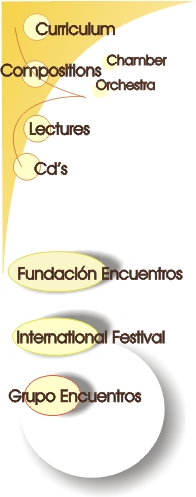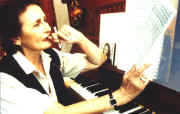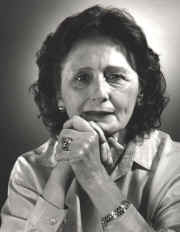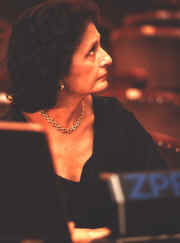




ALICIA
TERZIAN Born in Córdoba, Argentina on July 1st 1934. Argentine composer, orchestra conductor and musicologist of Armenian desdendant. She studied at the National Conservatory of Music and Performing Arts of Buenos Aires with Alberto Ginastera, Gilardo Gilardi, Roberto García Morillo and Floro Ugarte among others. She graduated in piano (1954) and composition (1958) with the First Prize and Gold Medal (1959). In 1962 she traveled to Europe to study bout IVth and XIIth Armenian medieval religious music with Father Leoncio Dayan at the Mekhitarist Monastery of Saint Lazaro, Venice. She completed her formation by styding orchestral conducting with Mariano Drago and later on, electronic music. Her activities as composer, conductor, musicologist and difussor of contemporary music, have contributed, since he was very young, to her acknowledge both in her own country and abroad. She has received many important prize, apart from that mentioned above, the First Prize of the Municipality of Buenos Laires City (1964), the “Francisco Solano” Award (1968), The Argentine Outstanding Young Musicians Prize (1970), National Fund for the Arts Prize (1970), First National Prize of Music (1982), Gomidas International Prize (1983), the Academic Palms Medal from the Government of France, the Saint Sahak and Saint Mesrop Medals given by Pope Vasken I of the Armenian Church (1992), the “Alberto de Castilla” Medal of Colombia (1994) and the Mozart Medal given by the International Music Council (1995). Terzian has developed her activities in the field of education giving classes at the Municipal Conservatory, National Conservatory of Music and Performing Arts (1960, Musical didactic, Pedagogic training, Harmony and Counterpoint)) at the Superior School of Fine Art of the National University of La Plata (1967, History of Music), at the Superior Institute of Arts of the Colon Opera House (1968, History of Opera) and in the programme Introduction to Argentine Culture of the Institute of the ........... (History of Argentine Music) and the National Institute of Public Administration of the Argentine Republic. Her activities as lecturer are also remarkable in many countries of Europe, Asia and the three Americas and about different subjects (religious and folk Armenian music, music written by women, Argentine folk and academic music, Ibero American music and XXth century music). Because of her studies of Armenian religious music, she developed an interesting task within the frame of Musicology, attended meetings such as the Assembly of the International Society of Musicology in Ljubljana (1967) where she was included in the Consultive Committee as the secretary of theExecutive Committee of the International Musicological Society. Some of her works have been presented before different Forum such as the University of Yale (1968) or published in the prestigious Revista Musical Chilena ( Chilean Musical Magazine) among others. In 1968, Alicia Terzian created the Encuentros Internacionales de Música Contemporánea (EIMC) Foundation from which she is the artistic director taking into account Ginastera’s advise, She created this Foundation that soon would take the place of the Latin American Center for Latin American Musical Studied of the Di Tella Institute of Argentina in the aspect of diffusing the music of her own country as well as the Ibero American and the universal. The Encuentros Festivals have been since then a big Forum of contemporary Latin American music (from 1979 it is the Argentine Section of the International Society for Contemporary Music). In 1979 Alicia Terzian created the Grupo Encuentros with the aim to promote the knowledge, in Argentina as well as abroad, of the music written by Latin American and Argentine composers. It is the only permanent group of this characteristics in Latin America and one of the few that maintain and wide career in the field of contemporary music in the world counting over 200 concert given in the most important festivals of the five continents. The group – conducted by Alicia Terzian and formed of mezzosoprano, flute, clarinet, violin, celo, piano and, occasionally, other instruments, actor, dancers according to the works to perform – makes annual tournées making the Ibero American music know all around the world. Adding to the activities mentioned, we can name the following: Alicia Terzian is in charge from 1979 and annually, of the Argentine selection for the World Music Days organized by the International Society for Contemporary Music and the International Rostrum of Composers organized by the International Music Council of the Unesco; from 1985 she is the President of the Argentine Music Council of the Unesco; conductor of the “Ensemble Casella” of Torino in the official winter session, 1987; Vicepresident of the International Music Council of the Unesco, 1990; Regional Secretary of the International Music Council (IMC-UNESCO-Paris) for the Three Americas (COMTA); Delegate before the International Rostrum of Composers in Paris (IMC-UNESCO-Paris); Director of the National Fund for the Arts (until 1989); Artistic Director of Cablevision; Vicepresident of theWomen Intrnatinal Council of the Unesco; Vicesecretary of the Argentine Union of Composers; Permanent General Secretary of the Argentina Society of Musicology; founder of the Argentine Branch of the International Federation of “Musical Youths”; founder of the Latin American Council of Music; member of national and municipal juries of Composition and Musicology Competitions; from 1979 she acts as a jury in Argentina for the selection of works to present before the World Music Days Fetival organized by the ISCM (International Society of Contemporary Music); jury in many contests organized by the National Superior Conservatory of Paris, 1983; international jury in the Festival of Ibagué, Colombia; international jury of the Composition National Competitions of Colombia, 1998; jury of the 2nd Ibero American Prize in Oporto, Portugal, 1998; Jury of the Sacred Music Festival of Fribourg (1995) and Jury at the International Competition of Orleans (2002) and Composition in Taiwan (2002). Concerning
her career as composer, Terzian herself differentiates 3 stages:
the first would span from 1954, when she began writing, to 1964
with her Movimientos Contrastantes. In this stage, we can mention
works such as Toccata for piano and Danza criolla. The composer
says that she is linked to the tradition although it is not evident
in the language. The politonalism and microtonalism are definitive
features of this stage in which Terzian uses her knowledge about
microtonalism as a result of her musicology studies in Venice about
medieval religious Armenian music. The microtonalism makes its appearance
in works such as Concert for violin and orchestra or the Pieces
for quarttet. Is in this period in which Terzian shows an outstanding
mastery of the academic technic, the fruit of a solid musical formation.
WORKS Scene: Hacia la luz, ballet, 1965; Movimientos, ballet, 1968; Correspondencias, 1969, incidental music ; Achtamar, ballet, 1979; El Dr. Brecht in the Colon Theatre, musical theatre, 1981; Bertoldt Brecht at the Salón Dorado, musical theatre, 1982-83; Juana, Reina de Castilla y Aragón, hija de los Reyes Católicos, ballet, 1983. Orchestral with soloists: Concierto para violín y orquesta, Op. 7, 1955; Tres piezas ("Canción del atardecer" - "Pastoral con variaciones" - "Danza rústica". (Versión para orquesta de Tres piezas para cuarteto), 1955; Movimiento sinfónico, 1956; Primera Sinfonía, 1957; Movimientos contrastantes I, 1964; Gris de la noche, Nº 6 de Imágenes cósmicas I, timbales y orquesta de cuerdas, 1970; Proâgon violín. y orquesta de cuerdas, 1969/1970; Carmen Criaturalis, corno, orquesta de cuerdas, vibráfono y platillos, 1969/1971; Y cuya luz es como la profunda oscuridad, para orquesta de cámara, pinturas de M. A. Vidal, 1982; Off The Edge..., barítono solista, orquesta de cuerdas y Tam-Tam; 1992/93. Choir
and Orchestra: Cantata de la tarde, (orador, coro mixto y orquesta),
1958; Introducción y cántico de primavera, (coro y
orquesta), de El cantar de los cantares de Salomón, 1958; Symphonic
band : Movimientos, versión para banda sinfónica de
Movimientos contrastantes, 1964; Atmósferas II, Nº 3
de Imágenes cósmicas I, 1969. Soloist: Danza Criolla, piano, 1954; Suite, piano, 1954; Toccata, piano, 1954; Sonata, piano, 1955; Canción y Danza, 1955, versión para guitarra; Juegos para Diana, piano, 1956/65; Cuaderno de Imágenes, órgano, 1964; Shantiniketan (tiene tres versiones: flauta sola; flauta y recitante; flauta, recitante y mimo o bailarín), 1979; Yagua-Ya Yuca, percusionista solista, 1992;Oda a Vahan ,piano y tape,1996;Tango Blues,piano,1999;Ofrenda a Bach, organo, 2000.
Curriculum - Reviews Alicia
Terzian is an internationally renowned figure recognized through the different activities that form part of her own
personality: composer, musicologist specialized in the Latin American
history of music, conductor, organizer of music institutions devoted
to the diffusion of the music in her country and abroad as well
as her untiring task to diffuse internationally young Argentine
interpreters and composers. A
student of composition
with Alberto Ginastera and sacred Armenian musicology from the IVth
to the XIIth centuries with Father Leoncio Daian (Venice), Terzian
was awarded many composition prizes: Municipal Prize in 1964, National
Fund for the Arts Prize in 1979 and 1982, and the First National
Prize of Music in 1982. She
was also decorated as Chevallier de l’Ordre des Palmes Academiques
by the Government of France in 1987, the Saint Sahag and Saint Mesrob
Medals given by the Pope of the Armenian,Vazken 1st in 1988 and
the Mozart Medal given by the International Music Council in 1995.
She is a member of the National Academy of Fine Arts of Chile, Artistic
Director of the Encuentros Internacionales de Música Contemporánea
Foundation, Member of the International Music Council of the UNESCO,
President of the Argentine Music Council and Regional Executive
Secretary of the Music Council for the Three Americas (COMTA-CIM-UNESCO). Terzian
received many commissions: Gulbenkian Foundation of Lisbon, London
Ices Festival, Festival of Zagreb, Aspekte Salzburg Festival, Banco
Mayo Foundation, Grenoble Orchestra, Radio France,
Dutch pianist Marcel Worms,
Argentine organist Adelma Gómez, Ensemble Contemporánea of
Denmark, Dutch bass
clarinetist Harry Sparnaay and Simón Bolívar Orchestra of Venezuela, among others. She
taught composition, orchestration, counterpoint, history and aesthetics
of music at the National Conservatory of Music, Municipal Conservatory
of Music, Fine Arts
Faculty of the University of La Plata and the
Institute of Fine Arts at the Colon Opera House. She
usually gives seminars,
workshops and radio
lectures concerning the Argentine and Latin American contemporary
music at most important conservatories and universities of Europe,
Far East and the three Americas, as well as on European and American
radios (over 3000 since 1967 onwards). In 1968 she organized the Encuentros Internacionales de Música Contemporánea Foundation which, since 1979, are the representatives of the International Society for the Contemporary Music in Argentina. She has developed an intense annual activity through this institution organizing concerts, seminars, radio and television programmes, the Argentine Tribune of Composers, and edition of compact discs. As
the Artistic Director of the Encuentros Foundation, she has been
promoting the music of Argentine composers in the past 21 years,
presenting their works before the International Tribune of Composers
(UNESCO, Paris) and at the annual festivals World Music Days organized
by the ISCM. As
the conductor of the GRUPO ENCUENTROS (created in 1978),she realized
21 international tournées in 4 continents, performing over 190 concerts
and presenting 70 new works written by Argentine and Latin American
composers. The GRUPO ENCUENTROS has 4 CD’s: Raíces Americanas (American
roots), Las Vanguardias en Argentina (The avantgardes in Argentina),
Tangos y algo más (Tangos and something more) and Encuentros.....
con el tango (Encounters .... with the tango) As
the Regional Secretary of the International Music Council (UNESCO)
Alicia Terzian proposed and achieve the formation of the National
Councils of the UNESCO in: México, Guatemala, El Salvador, Replública
Dominicana, Ecuador, Colombia, Venezuela, Bolivia, Uruguay and gave
new life to the Councils of Cuba, Chile and Costa Rica. With this
important group of Latin American countries she realized in Cuba,
in March 2000, an important meeting of Presidents to promote a more
efficient musical action among the countries of the American continent. Many
musicologists have made their researches on Terzian’s musical works,
specially in Europe
and the USA. She
is oftenly invited as a Jury at important international
of composition and instruments competitions. She
has written works more than 70 works for different genres: chamber,
orchestra, soloist and orchestra, various instruments, choir, mixed
media, ballet, musical theatre, etc. Her repertoire is performed
annually at the impost important concert seasons in 5 continents.
She
counts with CDs edited
in France by the recording company
Disques DOM . The
official European radios devote their emisions very often to diffuse
her personality and music Score
editor: Ediciones Encuentros
CD
editor:
Disques DOM Dom Disques - Rue Jules van Zuppe 14 Reviews Las
conferencias de Alicia Terzian en el Auditorio Gulbenkian Nº 2 confirman
una vez más su importante personalidad y su talento como compositora.
Diario de Noticias, Lisboa, Portugal Escuchamos la obra de Alicia Terzian en su conferencia, comprobando que, además de su elocuencia posee un gran talento como compositora. El Excelsior – México. “Shantiniketan”
es una suerte de ceremonia que envuelve a la audiencia y muestra
el diálogo entre la flauta, las luces, los movimientos, el sonido
y una etérea coreografía. L.F. – Paese Sera – Roma Alicia
Terzian es una gran compositora. G.F. Ghedini – Roma La
obra “Voces” de Alicia Terzian tiene
un gran poder dramático, una intensa humanidad que envolvió a la
audiencia, quien aplaudió la obra de manera continuada. Napoleón
Cabrera – Clarín – Buenos Aires “Carmen
criaturalis” de Alicia Terzian es una música inteligente,
con algo de salvaje y primitivo, de intenso poder que convence y
misteriosa energía. C. Magrini – El Cronista – Buenos Aires La
“Sinfonía visual” de Alicia Terzian
dio fuerza a las imágenes visuales penetrando en el más secreto
conocimiento de los sonidos. Su obra lidera un nuevo significado
en la música. L’Unitá – Roma. “Atmósferas” para dos pianos de Alicia Terzian expresa elocuentemente la inmensa capacidad creativa de la compositora argentina. Diario de Noticias- Lisboa. Alicia Terzian dirigió la Orquesta de Cámara de Aosta. La Terzian, los instrumentistas de la orquesta y Oscar Alessi debidamente motivados dieron vida a una interpretación excelente perfectamente en espíritu con la obra. Escuchando es casi difícil estar sentado en su asiento porque la tentación es de alzarse y ponerse a danzar. P.Gall – La Stampa – Italia. Alicia
Terzian tiene una doble vocación de compositora y directora, con
un talento tal por la que es reconocida hoy en día como una de las
personalidades más dinámicas de la música contemporánea de vanguardia.
Louise Vallin – Femme – Suiza Alicia Terzian se afirma, con “Voces II” como una compositora de talento ardiente y delicado. Daniel Robellaz – Suiza. Alicia
Terzian en “Voces” generó constantes
cambios y énfasis en su música. Meirion Bowen
- The Guardian – Inglaterra A
la cabeza de su conjunto Alicia Terzian dirige con atención precisa
y de manera infatigable. Con ella la música contemporánea argentina
posee una animadora de valor equivalente latino de nuestros Diego
Mason o Paul Mefanó. Su concierto fue una de las manifestaciones
más cautivantes del festival. M.M. – Le Nouvelle d’Orléans - Francia. |